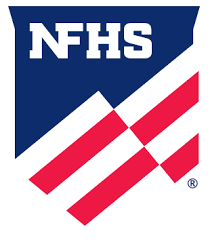By Marty Maciaszek
Director, Communications and Team Dealer Division
and Tom Van Jacobs
Marketing Coordinator
DOWNERS GROVE, ILLINOIS (April 15, 2021) – The National Federation of State High School Associations (NFHS) and the NCAA held their annual rules meeting April 13-14 after a one-year hiatus because of the COVID-19 pandemic. This year’s rules meeting was held virtually and NSGA attended all the sessions to provide a recap.
One key takeaway is the NFHS and NCAA are likely to try and minimize rule changes affecting uniforms and equipment, unless it is related to a safety issue, because of the financial crunch schools are facing because of revenues lost from COVID. Another is some COVID-related rules toward safety that are likely to carry over into the 2021-22 school year.
Football
Bob Colgate of NFHS shared a reminder that the rule regarding gray home jersey goes into effect with the 2021 fall season. Jerseys must be a 70 percent grade of gray or up to be permissible and white jerseys can’t have any shade of gray. Vegas Gold-colored jerseys are currently permissible to be worn by the home team. And as of 2024 the entire body of the jersey number must be a single, solid color which clearly contrasts with the body of the jersey.
The NCAA’s Steve Shaw said points of emphasis for 2021 include uniform compliance regarding knee pads, pants, jerseys and T-shirts. Game officials have been instructed to remove players who are not in clear or significant compliance of related rules for one play initially. They also encouraged a review of uniform designs before they are ordered by a school.
Baseball
The NOCSAE requirements for baseballs and commotio cordis chest protectors are now in place for high school baseball by NFHS. Elliot Hopkins said the June baseball rules committee meeting will include a lot of talk about the future and how to best implement technology into the rules fairly and equitably for all schools. NCAA barrel compression testing of bats started in 2020 for Division I but was delayed for Divisions II and III until 2022.
Softball
The NCAA, NFHS and USA Softball are looking to get aligned on a change on specifications of the softball that would impact the compression. If it does go through, the organizations will be looking at timeline for when there are enough products meeting new specifications for a change to be made. NCAA bat testing of barrel compression before regular-season games goes into effect for all divisions in 2022. Rules editor Dee Abrahamson said that could lead to more bats removed from play.
Basketball
Regarding high school uniforms, Theresia Wynns of NFHS said “coaches and administrators must ensure legal uniforms are being ordered and purchased. NFHS rules dictate the design (and not vice versa).” One example is a large picture of a team logo is not allowed on the jersey front where the school name or nickname goes.
There is a push from some corners of the sport to institute a shot clock throughout the country in high school basketball. The basketball rules committee was scheduled to meet the third week of April.
“We talk about a shot clock all the time,” Wynns said. “The basketball rules committee has considered the shot clock, but they haven’t been overly enamored by it, so it hasn’t passed at the high school level. We’ll have a discussion and see where the committee goes with a shot clock.”
Since this is an NCAA rule change year, Jon Levinson said there are some potential uniform and equipment changes anticipated at its annual rules committee meeting May 5-7 since this is a rule change year. Levinson suggested, in order to avoid confusion, that manufacturers let the NCAA look at the design before it is sent to a school.
Volleyball
NFHS and NCAA said they were both approached by a company producing a clear plastic shield that could be placed over the net to minimize the potential for spread of disease. The NFHS and NCAA medical advisory committees did not believe this was medically necessary and there were concerns it could impact the game.
The NCAA said it anticipates officials will want to continue to use electronic whistles and is receiving requests by officials to continue wearing masks. NFHS’ Lindsey Atkinson also shared the reminder that the body of the number color will have to clearly contrast with the body of the uniform color when the 2023-24 season starts.
Lacrosse
NFHS did not publish new rules for 2021 season because of COVID, but Dr. James Weaver and Atkinson said changes to the 2020 rules will be implemented in the 2021 season. For girls lacrosse, equipment shall not be modified from its original manufactured state and shall be worn in the manner the manufacturer intended it to be worn. Also, girls’ eyewear on the playing field must be SEI certified. For both boys and girls this year goalkeepers must wear a chest protector for lacrosse that meets the NOCSAE standard. For boys, beginning January 1, 2022, field players must wear shoulder pads that meet the NOCSAE ND200 lacrosse standard for protection.
The NCAA’s Jay Fitzwater talked about upcoming changes to women’s jerseys that will begin in January of 2022. Fitzwater said jersey numbers must be a color clearly in distinct contrast with the color of the jersey, irrespective of any border around the number.
The NCAA’s Andy Supergan also talked about two men’s changes that will begin January 2022. Supergan said all field players must wear shoulder pad protectors, or an alternative protective device, certified to the NOCSAE commotio cordis protective device standard. The other change is all institutions must have two visible shot clocks with the ability to set/reset the clocks to two different times.
Ice Hockey
Dan Schuster of NFHS stated this past year was not about rule changes but more focused on the return to play aspects. He does not anticipate any rule changes for the coming season when it comes to uniforms and equipment. Schuster mentioned Rule 3-4-2, recommended equipment which includes a throat/neck laceration protector, might be required in the future.
The NCAA’s Ty Halpin said its annual rules meeting will be in June and will not have any significant rule changes for uniforms or equipment. Two waivers were made for the 2020-21 academic year due to COVID-19 to help stop the spread and provide flexibility – the elimination of the postgame handshake and the ability to start a game with only two officials.
Wrestling
Hopkins said there were no equipment or uniform changes by NFHS for the 2020-21 season, but they have proposed new rules for the upcoming season during their annual meeting in early April. Hopkins also mentioned the need for officials is a priority. COVID has deterred many older officials due to the risks and wrestling needs to put efforts into recruiting younger officials and retention.
Hopkins said the growth of girls wrestling has been great to see and he anticipates a steady growth of participation as more states continue to sanction the sport.
The NCAA’s Ben Brownlee said 2021 is a rule change year for wrestling but there are no uniform or equipment rule changes being considered for the 2021-22 or 22-23 seasons. Waivers were also created for the 2020-21 academic year due to COVID to help promote physical distancing and a safe environment.
Track and Field
The 2020 NFHS rule book will be used this season. Julie Cochran of NFHS said there were no uniform changes in 2020 but there were changes regarding the exchange zone and the long jump pits. Cochran said the use of gloves in relay races will be permitted for the 2021 season.
The NCAA’s Rachel Seewald and Cochran were approached with questions regarding the shoe requirements World Athletics pushed out this past year and whether the NFHS or NCAA will follow suit. Seewald and Cochran stated the NCAA and NFHS will not enforce shoe requirements or restrict any shoe for athletes, if it does not have technology incorporated into the shoe that would enhance performance for the athlete.
Field Hockey
Julie Cochran of NFHS said there will be no changes to uniforms for the upcoming 2021 season. They did add the ability for a school to apply their logo to the goal boards if it does not dominate the goal board. Cochran mentioned the NFHS move this past year to recommend but not require goggles be worn during play in field hockey. She expects five of the 15 sanctioned states will require the use of goggles during play in the upcoming season.
Brownlee said NCAA field hockey is under structural changes when it comes to its rules committee. It is moving from a joint committee to a sub-committee. This is not a rule change year for field hockey and the committee will wait until after the Olympics to discuss any rule changes.
Brownlee went over the current uniform modifications in play for field hockey, which included requirements needed for team uniforms and jersey number requirements.
Soccer
The NCAA said the use of electronic whistles by officials raised some concerns because they were not easy to hear and could be a safety issue if play continues. It was mentioned it could be a growth area if electronic whistles were easier to hear.
Cheer and Dance
Weaver said the NFHS has seen some unusual headwear being worn as props in Dance routines will probably prompt some rules in the next year or two about headwear that is acceptable for costuming.
NFHS-NCAA Report
Dr. Karissa Niehoff, NFHS Executive Director, said she was pleased by the growth of girls flag football and NFHS “is seeing this really take off quite nicely.” Niehoff said they are also seeing a renewed interest in expanded school clubs and intramural opportunities to engage more kids in physical activities and eSports.
Niehoff also said NFHS has found “when (mitigation) strategies are in place, scholastic sports have not proven to be ‘spreader activities.’” She said more than 90 percent of contests scheduled have been played across the country.
One of the significant concerns for the NFHS and NCAA is the shortage of officials that has been exacerbated by COVID-related health concerns and schedule changes. Recruitment of newer and younger officials is crucial to addressing the problem.
“We have to protect the gatekeepers of the game,” said Anthony Holman, NCAA Managing Director for Championships and Alliances. “We need you to engage us to help in the recruitment of officials and development of programs.”
“We need officials to continue to purchase equipment and populate teams and grow programs,” Niehoff said. “The officials shortage is a legitimate factor about the numbers of programs that can happen.”
Niehoff said NFHS is concerned about budget shortfalls impacting state associations and school athletic and activities departments. She said another challenge for school administrators, athletic directors and coaches will be health and safety action plans that include a focus on risk mitigation for the spread of diseases such as COVID.
NOCSAE Update
Mike Oliver, Executive Director of NOCSAE (National Operating Committee on Standards for Athletic Equipment), shared an update on three new or potential standards.
A standard for headgear/face protection for touch or flag football is under consideration. Oliver said substantial injuries do occur to the face, teeth and eyes and NOCSAE is looking at whether headgear could substantially reduce those injuries.
Details are still being worked on with the youth football helmet standard. Producing a standard for shoulder pads is in the beginnings stages.





 Back
to News
Back
to News